#madoka meta
Text
Better to Serve in Hell than Rule in Heaven
Kyubey: I don't believe it. Your tainted Soul Gem should have disappeared with your soul, but it hasn't! Why?
Homura: Because I remembered why I repeated time and suffered over and over again; my feelings for Madoka, they run so deep that even pain has become precious to me. And as for my Soul Gem? A curse isn't what's tainted it.
Kyubey: Then what is?
Homura: Something you can't understand, Incubator. It is the pinnacle of all human emotion. More passion than hope, much deeper than despair. Love!
- Rebellion
I rewatched Rebellion today for the first time in about 5 years and was really struck by just how juicy Homura’s character is in the film – her selfish selflessness, her turning the whole way of the world upside down even as she perpetuates it. She’s heartbroken and guilty over leaving Madoka to sacrifice for the good of the world, so her solution here is to make herself the sacrifice instead.
If Madoka was to be a goddess, Homura’s fate is to stand against her and become the Devil. And so, she creates a paradise where no more magical girls have to suffer or become Witches or die, and where Madoka and her friends can live in peace. What’s so bad about that? The Incubators suffer, but they had it coming. Homura suffers, but it’s a sacrifice she’s willing to make.
But in the end, have things really changed? A magical girl becomes a godlike being and rewrites the entire universe to bring about her ideal happy ending, sacrificing her normal existence in the process. Madoka didn’t quite break the cycle, but rather softened it; magical girls still commit themselves to lives of endless fighting, but instead of rotting into Witches they instead find peace in Madoka’s arms when time runs out. Homura, in turn, smashes the cycle entirely, placing the burden of the world’s salvation on the Incubators’ backs… but at the cost of her own happiness.
In a sense, her Rebellion changes everything, but the logic of sacrifice endures. But perhaps this Rebellion against the world is a necessary step. For all the struggle and sacrifice, all Madoka could do was cheat a cold, cruel, impersonal cycle last-minute. But what Homura does is prove that love is stronger than such systems. And yes, it’s a twisted, flawed, unsustainable love, built on trapping Madoka in a pretty little cage as Homura tears herself apart from the inside. But it’s love nonetheless, triumphing over rigid laws and the cruelty of fate.
I’ve seen some complaints that Rebellion mischaracterises Homura – she would never do something as evil as rip Madoka out of heaven. But isn’t this basically the logical extreme of her entire raison d’etre throughout the series? Homura rewinds time again and again and again to prevent Madoka making a wish and becoming a magical girl, no matter what Madoka thinks. She takes it upon herself to become Madoka’s protector, and the painful truth is that the greater this love grows, the further she becomes from Madoka in truth.
So when Madoka decides on her final wish, Homura is terrified.
Madoka: I finally figured it out what I wanna wish for. I know what I want now more than anything else. And I'm ready to trade my life for it with no regrets.
Homura: But you can't! If you do then, everything I've fought for, it's all for nothing!
Episode 12: ‘My Very Best Friend’
Is it really such a surprise to think that the Homura who spent endless cycles fighting to spare Madoka from the pain of becoming a magical girl would hesitate to do the same to spare her from the pain of becoming a goddess?
At first, Homura tells herself that it’s OK. This is what Madoka wanted. But then when in Rebellion she tells Madoka about the terrifying ‘dream’ she had, where Madoka went far far away, never to be seen again, forgotten by everyone except Homura…
Homura: I was so lonely and sad... But no one understood how I felt. I started to think all my memories of you were just things I'd made up... I thought I was going crazy...
Madoka: You're right... That dream does sound awful. But it's okay now, really! I'm not going anywhere, especially if it's so far away I couldn't see you again. I'd never do something like that.
Rebellion
Everything falls apart. The sole consolation Homura had clung to – that Madoka was happy, that the sacrifice was worth it – comes undone. Madoka would never do something like that. How could Homura let her best friend throw her life away like that?
Madoka has no idea, of course – she has no idea how brave she’s capable of being, how much courage she has to spare for the sake of the world. But for Homura, this is where she realises that she’s made an incredibly stupid mistake.
For Homura, anything that causes Madoka pain is automatically her enemy. And when she realises how much pain becoming the Law of Cycles caused her – well, the logical conclusion is that the greatest threat to Madoka’s wellbeing is Madoka herself.
Homura: Well then, I suppose one day, you'll also be my enemy. It's fine, I don't care. I'll keep wishing for a world where you can be happy.
Rebellion
So Homura selfishly chooses to override Madoka’s wish, out of pure, selfless love. Out of love for Madoka, she turns herself into the Devil, a suitable foe to fight a Goddess. Out of love for Madoka, she has imprisoned the girl within a prison of illusions. Out of love for Madoka, she has essentially renounced Madoka’s love.
There’s something utterly selfless about this. Homura is willing to make Madoka – her little pet bird singing sweetly in a silver garden – her enemy. She puts Madoka’s welfare first and foremost, even if it means someday Madoka might reject her, or fight her, or perhaps even hate her. In order to prove her love for Madoka, Homura is happy to never be loved by Madoka in return. Without hope, without witness, without reward, she takes the burden from her shoulders. Better to serve in Hell than rule in Heaven.
But there’s something undeniably selfish here. Who cares what Madoka wants? Madoka comes all the way to save her from her self-inflicted hell within the Soul Gem, and yet Homura refuses because she knows best. Madoka’s job is sing sweetly by the window, never leaving, trapped within a never-ending beginning, with the door to adulthood firmly closed. Madoka is not really a human, a girl, a friend – she’s an idol, to be cherished and protected by any means necessary.
If witches are born of the selfish wishes of magical girls (such as Sayaka’s wish done in hope of having Kyousuke fall in love with her), and goddess born of pure and selfless wishes, then it’s no surprise that Homura’s selflessly selfish love would create the Devil herself.
#i never write long posts but i had a half-decent one from years ago i wanted to edit#not that this is a deep novel insight tho i just think homura's neat#pmmm#madoka magica#madoka meta#homura akemi#homura#puella magi madoka magica#pmmm rebellion
21 notes
·
View notes
Text
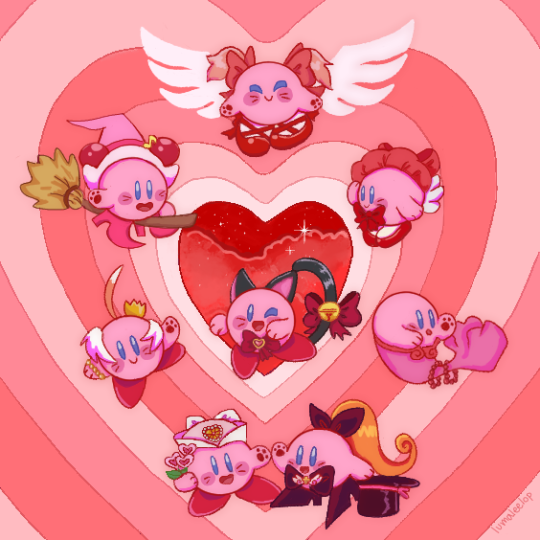
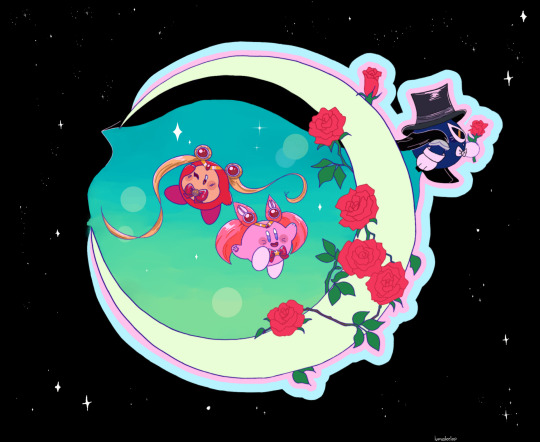
Kirby has all the qualifications to be a mahou shoujo protagonist!
#kirby#meta knight#sailor dee#sailor moon#pmmm#madoka magica#puella magi madoka magica#card captor sakura#tokyo mew mew#ojamajo doremi#princess tutu#mermaid melody#mermaid melody pichi pichi pitch#nurse angel ririka#nurse angel ririka sos#saint tail#mahou shoujos#magical girls#nintendo#nintendo fanart
586 notes
·
View notes
Text
reminder that homura is a middle schooler. she is 13 or 14 years old, depending on source. she is not old enough to drive or have a permit. she is not old enough to live on her own (it's implied her parents are out of the picture in some way — in the US she'd need to be in adoptive or foster care, or at least have a guardian or social worker, but this appears to be handwaved in the series and none are ever shown). she cannot vote. she is not old enough to get a job (earliest i've seen is 14 in the US, and that's usually in not great environments, in summer, and for low pay and short hours). she is only "independent" in the sense that it's forced upon her by lack of any adult support — nobody helps her fill out school transfer forms, she lives alone, she has no shown family or even mentions of relatives, nobody visits her in the hospital, etc.
i say this because a lot of "anti homura" arguments act as if this information doesn't exist, and that homura is "actually an adult" or at the same level as one due to looping. she canonically is not. her brain and physical body are not developing, she is only learning walpurgis tactics and memorizing test answers. her brain is not developing so she's not "mentally 26", like is often claimed by "homura is a predator" truthers. i'm not even going to touch on how weird and borderline creepy it is to say "she's a child but so mature for her age (from extreme, repeated, potentially pre-series trauma), so she must be an adult and can be treated like one".
there is a reason that children are typically tried differently in the US. unless "tried as an adult" for very serious crimes, it is widely accepted that children (and even young adults) are more impulsive, think less rationally, and are generally "less responsible" for their actions due to not having the experiences of a full grown adult. children are less mature, more prone to "overreaction" and panic, and are immature — because they are kids.
homura is a child. she also has extreme trauma, potentially from before the series even began (where are her parents? are they just neglectful? dead? why isn't there even a single adult helping her?) that is never helped or addressed. homura doesn't get help for any issues she has (obvious ptsd and depression, borderline delusions over the past being "just a dream" in wraith arc). she is not some spoiled, rich, mentally stable almost-adult who's never faced a consequence. she is a young and traumatized teenager, young enough to be a middle schooler, and has experienced:
neglectful, absent, missing, or dead family/parents
watching her friends die horrifically almost a hundred times
having zero adult support at all, no caseworker or help
bullying, half being because she's disabled
having her soul ripped from her body without consent and learning if she ever loses her soul gem (or god forbid accidentally drops it somewhere), her body will basically be "dead"
learning she and all her friends turn into eldritch horrors when they die, a process shown in rebellion to be something they are aware for (aka the horror that witches aren't "just" bodies being moved, they are actively and constantly suffering and aware to some degree the whole time)
learning that the witches they fight are girls around their age who fell into despair, and not purposeless monsters
learned of the prospect that witches can potentially "regrow" via familiars, thus if their consciousness transfers, this shows the possibility of literally eternal suffering as the witch is "reborn"
realization that, the more she tries to save madoka, the worse the situation gets
having a full on breakdown with delusions in wraith arc, thinking maybe madoka was all just a hallucination or a dream she had
finding out in rebellion it wasn't a dream, but then thinking she betrayed madoka by not stopping her from contracting
becoming a witch whose whole theme is based around suicide and wanting and waiting to die, but not being able to
being a witch whose familiars are malicious towards her and belittle her
trying to "fix" her believed betrayal of madoka by making a new world, ending up hated by sayaka and isolated from her friends
is still stuck as a witch while the last event happens!!! (her soul gem is never shown purified)
all of this while she is 13-14.
homura is not some cruel adult playing god because she is bored and likes the power trip and wants the world to burn. she is a deeply traumatized and mentally ill child who never got help. she is not a predator — and i honestly don't know if that is more of a "she's a predator because she's the most openly sapphic" or "she's a predator because she's traumatized and thus 'acts weird' due to trauma" belief nowadays in most anti-homura spaces, i've seen both. she is not a murderer or rapist or whatever else i've seen (yes, "homura is a sexual predator" claims exist, despite this never once even being implied). she is not an abuser — you can argue she's cold or rude, but she is not "an abuser".
if a child like homura existed irl (and they do exist), a professional's first thought would not be "this is an evil, irredeemable, abusive predator who can be treated like an adult", it'd likely be a reaction of horror and deep concern of "what happened to this child to make her act this way?". someone being "the perfect victim" — that is, being soft, demure, sweet, docile, flawless — in response to trauma is a harmful myth for a reason. some trauma victims will react with anger. some may be overly happy in an attempt to prevent further abuse. some, like homura, end up acting "cold" to try and avoid being further hurt. it doesn't mean homura doesn't experience emotion, hates her friends and wants them to suffer, is a predator, is "a bad person", etc.
think! when you write posts about how homura is actually an evil, awful, no good, very bad person with no positive traits, remember she is a middle schooler. of course, she's not a "real" child, and thus doesn't exist to have her feelings hurt over it, but consider this: would you say these things to/about a real child? are you aware that "real children" (often victims of trauma themselves) relate to homura due to this? i was one of them at 14ish, and while "homura is evil [for acting like a traumatized child often does]" discourse never left me particularly hurt, i know it does genuinely upset several people i know. and if you had, say, a real life child relative who acted "cold" after seeing their friends die horribly, would you call them an evil and irredeemable abuser as well?
#long post#pmmm#meta#madoka magica#homura akemi#nnnot my best work but 'homura not act like perfect victim of trauma? obviously EVIL PREDATOR ABUSER' takes take decades off my lifespan#abuse m#neglect m#tbh i only remembered the 'familiars can regrow witches' plotline while writing this and Realized. good fridge horror.#very long post#essays#ish
222 notes
·
View notes
Note
There's a weird, weird, weird criticism of PMMM that revolves around the girls being pitted against each other and how Madoka's wish in the finale somehow is a statement on the "model woman."
Like... I get that pop culture too often has girls going at each other in a vibe that amounts to, "girls, amirite?" but Madoka Magica felt like it treated any of the sort with nuance and an in-universe reason.
If they knew how much the Incubators were screwing them over and the info Kyubey often withholds, they'd team up and fight the power hands down.
Would Kyoko and Sakura not put aside their differences if all we know of Kyubey now was known by them while the former was still stable enough? Would Mami not have tried to gun down Kyubey along with Homura if she learned the truth (preferable not after having to kill Sayaka as a witch)?
I know, that's such a dumb criticism. It's explicitly shown in the series that, unlike most magical girl series where everyone is best friends, the girls don't get the chance to do that because the very nature of the magical girl system in PMMM makes them compete for limited resources.
They're not catty girls fighting over shoes and boys, they're literally fighting for their survival and unfortunately making friends can get in the way of that. I think it's actually a really good critique on systems that divide us like capitalism and white supremacy; we could all be friends and help each other, but there are oppressive systems and structures in place that make us compete with each other.
Moreover, the effect this competitiveness has on the magical girls is shown in great detail with Mami (especially in The Different Story manga). She's desperate, lonely, and depressed because she doesn't have anyone to confide in.
It's no wonder that, when resources aren't as much of an issue, magical girls tend to band together. We see this in Magia Record, where lone magical girls are the rare exception and not the rule thanks to the purification barrier. In fact, a few events showcase non-Kamihama magical girls trying to infiltrate and stir up discord among the Kamihama magical girls only to fail because they're all on good terms with each other, if not straight-up friends and teammates. In Madoka's new universe, magical girls also fight together on teams because they're not competing over limited Grief Seeds.
So yeah, the lack of teamwork in the main series basically boils down to "oppressive systems inherently work to divide the people to keep them from banding together and unlocking their full potential." Man, I really need to write an analysis on the socialist implications of PMMM lol
71 notes
·
View notes
Text
color symbolism in madoka magica
Obviously colors are important in PMMM, each soul gem is assigned to each girl based on a color, and the girls have very prominent color schemes, but why each color scheme for each girl? And does it go any deeper than that? I am going to pick it apart one color at a time going in rainbow order, first by analyzing what each color means to each magical girl and their wish, and then applying that to where else the color can be found in the series. (this is my first meta post pls be nice to me)
RED - PASSION
Red is Kyoko’s signature color, representing her passionate and abrasive nature. Her association with red represents her attitude and fiery energy, as well as her wish. Her wish was for people to respect her father, and listen to his teachings and passions. She’s a veteran, and a very powerful magical girl.
In addition to Kyoko, Kyubey has disturbingly red eyes because it’s super creepy, but also because he’s a very powerful figure in the show. Only his eyes are red, representing power and a strong will to achieve a goal, but not a true passion.
At the very beginning of the series, there is a scene with Madoka and her mother about choosing which hair tie. Her choice is between a yellow one and a red one, and ultimately Madoka chooses the red one, encouraged by her mother. Madoka’s mother is also associated with the color red, being a powerful businesswoman and role model.
In Madoka and Homura’s scene together in between worlds, Madoka gives Homura her red hair tie. Homura keeps the hair tie and wears it in honor of Madoka’s sacrifice in the new reality. Homura, now having the hair tie, adds a red element to her purple and black color scheme that was not present before. Madoka, on the other hand, loses all red in her color scheme. The hair tie serves to ask the question: did Madoka really choose her passion? Madoka wanted to live, we see that frequently in the series. She hesitates to become a magical girl all throughout the series because of this desire to live. She wants a normal life, but she puts the well being of others over her own. That being said, her desire to help others does not erase her desire to live. In a perfect world she would be able to do both, but instead, she passes the baton (or more literally the hair tie) to Homura, who only ever wanted to save Madoka from her cruel fate. Homura then gets to live her life free of becoming a witch. Power, true power, is in living your life the way that you want to. Kyoko lives her life the way she wants. Madoka’s mother lives her life the way she wants. But not Madoka, who gives up her red hair tie in hopes that Homura can live her life the way she wants.
Rebellion takes Homura’s desires to the absolute extreme, and the color red is not absent in showing it. Homulily dons red spider lilies, and Homura wears the red hair tie all throughout Rebellion, except for the very end when she gives it back to Madoka. When Homura has the hair tie, she follows her passion, which is to save Madoka and give her a normal life. At the end of the movie she accomplishes this goal, and gives the hair tie back to Madoka. Homura gives up her chance at a normal life so Madoka can have one. Akuma Homura also has plenty of red in her color scheme, further enunciating that Homura’s devil form is the epitome of her desire to give Madoka everything she deserves.
ORANGE - ACCEPTANCE
Okay red was a long one I promise they’re not all this long this color is a lot less complex. Orange is Nagisa’s soul gem color, and most likely represents acceptance, but I’d love to hear someone else’s ideas on what orange might represent. Nagisa’s wish was to finally do something to impress her mother and to be loved by her. However, after her mother’s death she accepts that her mother treated her horribly, and instead seeks acceptance in other people and eventually finds it in Mami Tomoe.
YELLOW - SELF SACRIFICE
Yellow is Mami Tomoe’s soul gem color. Mami, as her name suggests, is a very maternal figure in the show specifically for Nagisa, Sayaka and Madoka. She protects them, advises them, and cares for them. The color yellow represents self sacrifice. Mami puts herself in harm’s way and ultimately perishes for it in order to show Sayaka and Madoka the gruesome nature of being a magical girl. This is in stark contrast to her own wish, which was to save herself. Her guilt over this wish drives her selflessness. She couldn’t save her family, but she can save others.
Madoka’s eyes turn yellow in her goddess form because she has made the ultimate self sacrifice for the fate of all magical girls. In the very beginning of the series, Madoka is encouraged by her mother to wear the red hair tie over the yellow one. Her mother opposes her decision to sacrifice herself, just as she opposed the yellow hair tie. At the very end of Rebellion, Madoka arrives at the school wearing the yellow hair tie, representing her past self sacrifice. As discussed earlier, Homura switches out her hair ties, replacing her self sacrifice with the desire and passion to live the way she wants. Madoka does not want to die, she wants to live the way she wants to, but ultimately when given the choice she will always choose to save others over herself. Without the influence of others, Madoka will choose to sacrifice herself. She will choose the yellow hair tie even if she doesn’t want to.
It’s worth mentioning that in color theory, yellow is the opposite of purple. I’ll get to purple later but it’s interesting that Homura’s signature color, which represents love, is the opposition to self sacrifice.
GREEN - NORMALCY/THE REST OF THE WORLD
Green is Hitomi’s color, and it represents normalcy. Green is the rest of the world outside of the magical girls. Green is the color of nature, and nature opposes magic.
BLUE - REGRET
Sayaka Miki’s signature color is blue, and it represents regret and sadness. Different from the despair represented by the color black, blue represents sadness as a natural part of life. Regret is inevitable, everyone makes bad decisions, but ultimately the goal is to not fall into despair and lose control of your life because of it. (Sayaka actually comments on this in Rebellion while fighting Hitomi’s nightmare!)
PURPLE - LOVE
Homura Akemi’s signature color is purple, representing love. Homura’s wish is based on her love for Madoka, and everything she does is for Madoka’s benefit. In Rebellion, in the flower scene, the flowers turn purple as Homura tells Madoka how important she is to her. Purple represents her original wish, while black represents what she becomes, which I will explore later.
PINK - HOPE
Madoka Kaname’s signature color is pink, representing hope. Madoka becomes the manifestation of hope, in contrast to despair. I forgot where I read this but in the original timeline Madoka uses her wish to save a cat. To save someone else is to hope that they will be okay. Madoka has hope for everyone around her, almost to a fault.
Pink is also a secondary color on Kyubey, representing the false sense of hope he gives to magical girls.
BLACK/WHITE - CONTROL
Black and white are interconnected in their symbolism so I’ll group them together. White is Kyubey’s color, while black is the color of grief seeds and witches. Black represents despair over a lack of control, while white represents overwhelming control. Witches are magical girls who have succumbed to despair, and the blackness that clouds a soul gem represents this despair. Magical girls have no control over this destiny, and often when finding out about this fate they succumb to despair anyway. White is both Kyubey and Goddess Madoka’s color, and it can also be found on each of the color schemes of every magical girl. It represents the control that Kyubey has on each of their lives. Madoka as a goddess replaces Kyubey as the controller of the fate of all magical girls, with a primarily white color scheme.
The reason I grouped these two together is because of Homura. While Homura’s soul gem color is purple, her color scheme differs from the rest of the magical girls in that it doesn’t contain much of her soul gem color. She wears a black and white outfit, representing her control over time, and her lack of control over Madoka’s fate. Homura is in a constant struggle of how much control she is allowed to have over her and Madoka’s lives. She’s controlled by Kyubey and knows it, and she knows of her eventual fate. As Akuma Homura, the white in her color scheme is completely gone. She has accepted her lack of control over her own fate. She knows that eventually Madoka will realize her fate and they will inevitably be enemies because of Madoka’s overwhelming need to sacrifice herself for others. She accepts the fact that she cannot control Madoka’s fate, but the least she can do is attempt to give her a normal life for a little while. She is free from Kyubey’s control, but has also lost all control over herself and her desires. Homura acts only on her wants, while Madoka does not act on her wants at all. This push and pull dynamic is represented through the colors black and white.
#pmmm#puella magi madoka magica#madoka magica#madoka kaname#homura akemi#kyoko sakura#mami tomoe#nagisa momoe#sayaka miki#pmmm meta
223 notes
·
View notes
Text

So I attempted the color wheel challenge, and I loved it!! This was so much fun, and I loved drawing a bunch of characters people suggested for me on instagram
#my art#agent 8#splatoon#tepig#emboar#pignite#pokemon#mami tomoe#madoka magica#flowey#undertale#smb luigi#sorbet shark cookie#peppermint cookie#cookie run#meta knight#papi#kirby#twinkle popopo#dimentio#super paper mario#SO MANY TAGS#nutas art
211 notes
·
View notes
Text
there's a post that will eventually spit out of my queue about homumado and the subversion of Homura rejecting salvation to impose her own reality on Madoka that kind of captures what i'm about to say, but at the end of the day i'm feral about it because it's all about agency and trauma and the reclamation of power at the expense of others through the viewpoint of wanting to save someone.
I think it's like. The first 12 episodes of Madoka got us feeling like the whole point was Hope and sacrifice and fighting for what's right. and it kind of was. But with the next three movies it reframes everything, and with the trailer we just got I think it just confirms that. Madomagi isn't about hope, it's about power and agency.
Throughout the whole 12 episodes of the original series, Madoka has very little agency. She is tugged around by circumstances, watching helplessly as everyone and everything else falls apart around her. Homura, too, is without agency. She is trapped in an unending cycle where she is ultimately always helpless. It's the feeling of helplessness/hopelessness that drives magical girls to become witches.
Which, makes sense for the whole Themes. Kyubey is offering young girls, adolescents, a time of life where you feel sort of stuck and helpless in a world you're just understanding to be bigger than you thought, an illusion of agency. Make a wish, become a superhero, take charge of your own destiny. Make something happen with your own two hands. Have a measurable effect on the world.
But then wishes always go sour, and the fighting becomes endless and hopelessness sets in and you realize you were never in control at all. You were given an illusion of controlling your own life but in the end you were a puppet of fate and this ending was inevitable. You were always doomed to be powerless. Despair comes from the realization that nothing you do really matters and you have no true effect on the world except to continue its same sad cycle.
Madoka's wish and subsequent ascension is a total reclamation of agency and power. She takes the tools of the oppressor and reframes them to become eternity, to finally take control and become something greater that truly makes a difference in the universe. After watching everyone fall apart helplessly, she matures into the power to do something about it.
Then there's Homura. In the end, her struggle still felt meaningless to her. Madoka was able to ascend and change the world because of Homura, yes, but Homura's wish, her desire for control, was for Madoka to be alive, happy, and human. And that choice was taken away from her by way of Madoka's choice, leaving her to continue her painful slog through reality without the one person she cared about on yet another meaningless, eternal battlefield. She was helpless to stop Madoka from disappearing in the end, and she feels as though her choices are ultimately meaningless.
So at the end of Rebellion, it is Homura who decides to wrest her own agency. Unlike Madoka, who uses the system itself against itself, Homura comes from the outside and shatters the system. She regains control over a chaotic, impossible situation and becomes the power in charge of it.
But by doing so, she steals Madoka's agency, which Madoka worked so hard to develop and choose for herself. She makes Madoka helpless again.
And that is the crux of the story, and the reason why these two star-crossed lovers, at this point in time, are doomed to never be together - both of them desire agency, but their agency comes at the expense of each other. The only way for them to exert control over their own lives is if they put the other into a gilded cage of sorts - Madoka unintentionally, Homura on purpose. They have fallen into a dichtomy of belief that someone must be Saved and the other must be the Savior, and thus, they struggle, because the only way they can conceive of controlling their own lives in a way that gives them agency is through stripping agency from the other.
I sincerely doubt Walpurgisnacht Rising will be the final Madoka movie because I think they'll drag it out as long as possible, but I think the cycle of stealing agency from each other in order to gain their own sense of self will continue until one or both of them realizes that Saved and Savior are concepts that are inherently restrictive and still a part of the system that initially trapped them (see: Revolutionary Girl Utena). And it's going to be brutal for both of them because I think both of them have these ideas in their head of the other person and aren't truly seeing the other as full human beings who deserve to have the freedom to choose their lives.
They're going to continue to circle each other, struggling for dominance until they can break every part of the cycle of helplessness and see each other as true equals, and that's very toxic yuri of them and it drives me absolutely fucking insane i love these unhinged toxic lesbians ahhhhhHHHHH
94 notes
·
View notes
Text
Notes on Walpurgisnacht's mandala

I realized something interesting last night - Walpurgisnacht's mandala is drawn in the same style as her countdown signs. It's just difficult to see because normally her body is in the way, but you can clearly make it out in this shot from the "Prologue in Heaven" sequence in episode 1:
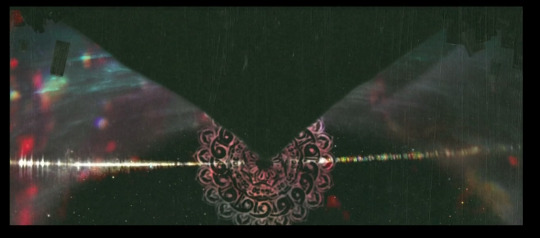
For comparison, here is what her countdown signs look like. As you can see, the little circles on the outside with the pattern that reminds me of a peacock's tail are present in both imagines.
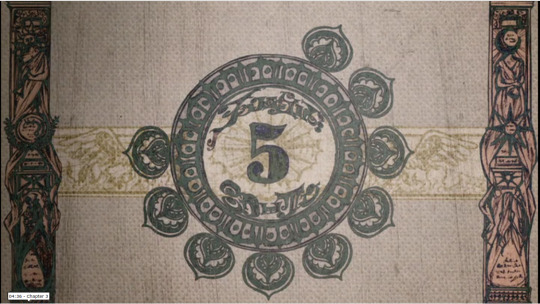
The next ring in on the mandala appears to be spirals that could be a stylized 6 or a 9, or a stylized hurricane.
The third ring has something that could be stylized runes--my guess is 'Walpurgisnacht', which the Puella Magi Wiki says is written in the countdown signs--but I have not been able to confirm that yet. And at the center is a stylized flower, from which a dark triangular shadow appears to issue.
(I have so many questions about what is going on in the "Prologue in Heaven" sequence and why it was included in the first place, but we'll leave it at that for now.)
By the way, the technical term for these signs is "film leaders"--they were inserted into the film to give the projectionist time to thread the projector. Once the countdown reaches the end, the film would often switch to a test image known as a "China girl" for color calibration. Is that what we're seeing in the Prologue, and that's why the colors seems to fluctuate for a moment? I don't know, but it's interesting to think about!
You know who else gets countdown signs? Homura! Here's one that the animators added to one of the recap movies immediately after a new scene where she walks through a skeletal forest:
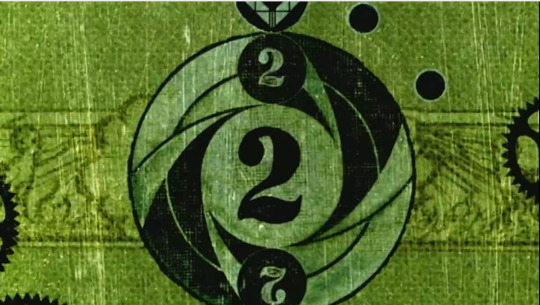
These have the same basic form as Walpurgisnacht's but are not as elaborate, and take the shape of Homura's shield. Note that they also have the similar spiral pattern as the second layer of Walpurgisnacht's mandala, too.
Both Walpurgisnacht and Homura's countdowns also have stuff going on the background--very stylized, ornate drawings that resemble nineteenth-century European engravings. Homura's also has cogs and gears, which are a recurring visual motif, while Walpurgisnacht's includes a star-shaped sigil that looks an awful lot like that of the Law of Cycles (minus the wings at the base):
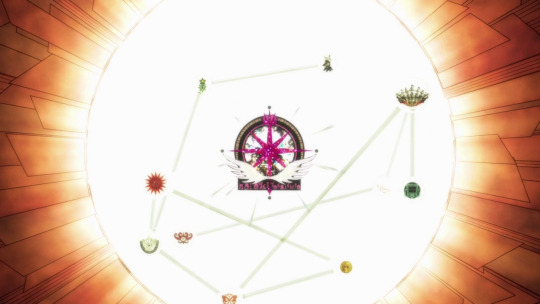
Here's a version of Homura's countdown from Rebellion, with a better look at the surrounding marks. Unlike Walpurgisnacht's, these are much less elaborate, but the ones at the compass-points take a diamond-shape, just like Homura's soul gem.

Note also that these move in time with the ticking of a clock--this is a time-keeping device, after all.
Just for fun, here's the Law of Cycles version, which combines elements from Walpurgisnacht's mandala with the circus pennants that Walpurgisnacht's familiars use to drag her along in the original series:

The obvious question for me is why Madokami has so many symbolic motifs from Walpurgisnacht--yes, we saw her absorb the witch at the end of the original series, but why use so many of those attributes, especially when Walpurgisnacht herself does not appear in this movie? What exactly is their relationship?
So what does this mean? I mean, I have my own theories, but for now, it's certainly interesting how much Walpurgisnacht and Homura (and Walpurgisnacht and Madokami) have in common, and these are details I hadn't noticed before. It will be interesting to see what, if any of this, is expanded upon in Walpurgis no Kaiten...
66 notes
·
View notes
Note
Do you think Utena and/or Anthy would have gotten a wish from Kyubey (not at seventeen, maybe, but we know they were children once, and Anthy's power is quite... powerful)? Would they accept, what would they wish for?
I mean, the way powers work in P3M is not whether you start out with magical abilities, but how much "influence" you have over the lives of others. So you have Sayaka, who was a relatively ordinary girl who used her wish only to help a single person was very weak, versus Madoka whose existence was the focal point of multiple timelines.
However, potentially, both Utena and Anthy would be power houses by those rules. Anthy fuels Ohtori, which granted only influences a very small number of people, but she seals Dios's powers which is implied to have had a very strong negative effect on the rest of the world. Utena revolutionizes the world and ultimately leads to Anthy leaving and Ohtori collapsing, so not as powerful but no slouch either.
But what they would wish for... Well, depends when they get caught.
We know Anthy would wish to protect her brother/remove him from those who wished to use him. That's what she used her powers for canonically and aiding the memory of her brother/punishing herself is why she complies throughout the series in the dueling nonsense.
Utena's a little harder because what she wanted changed as she forgot things and is also sometimes more cerebral. Utena when her parents first die wants 'something eternal' she's just lost her parents and future, she's realized she herself is going to die, and everything is mortal and fragile. Shortly after, however, she wants to become a prince so she can free Anthy.
But I think we've seen that both would accept the wish given the extremes they go to in canon to reach their goals even when facing great adversity.
#puella magi madoka magica#puella magi madoka magica headcanon#puella magi madoka magica meta#revolutionary girl utena#revolutionary girl utena meta#revolutionary girl utena headcanon#anthy himemiya#utena tenjou#meta#headcanon#opinion
34 notes
·
View notes
Text
Livi’s Color Wheel Challenge

Red- Sanrio’s Hello Kitty (Chosen by Me)
Orange- Henry Stickmin’s RHM (Chosen by @thehyperrequiem )
Yellow- Pikmin’s Yellow Pikmin (Chosen by Me)
Green- CRK’s White Lily Cookie (Chosen by @mikurulestheworld )
Blue- Madoka Magica’s Sayaka Miki (Chosen by Me)
Indigo- Kirby’s Meta Knight (Chosen by Me)
Purple- Love Live’s Nozomi Tojo (Chosen By Me)
Pink- JJBA’s Giorno Giovanna (Chosen by @kindabizarretbh )
Here they are!
#my art#art#digital art#hello kitty#Sanrio#right hand man#Henry stickmin#pikmin#yellow pikmin#cookie run#cookie run kingdom#white Lily cookie#madoka magica#pmmm#puella magi madoka magica#sayaka miki#Kirby#meta knight#love live#llsif#nozomi Tojo#JJBA#jojo’s bizarre adventure#vento aureo#giorno giovanna#color wheel challenge
68 notes
·
View notes
Text
Please keep in mind I don't know most of the ships/couples in the preliminary round. If you think something doesn't belong in this poll, vote that couple/ship out & please be civil!
For Kurogane and Fai:
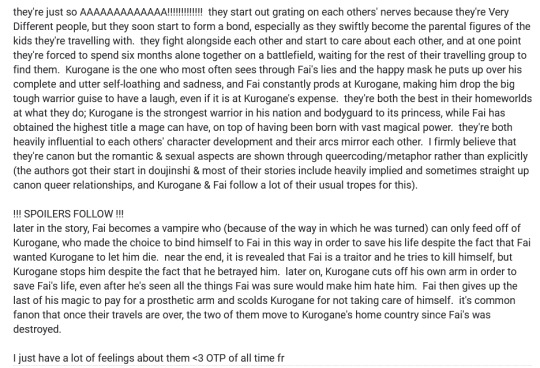
For Meta Knight and King Dedede:

For Snorpy and Chandlo:

#bqcb preliminaries#bugsnax#snorplo#queer as folk#kirby#meta knight#king dedede#nge#neon genesis evangelion#kawoshin#madohomu#madoka magica#tsubasa reservoir chronicle#kurofai
58 notes
·
View notes
Text
tbh, i like the way homura and madoka's magical girl outfits "clash" in a way.
madoka's is a very "typical". pink/pastel/cutesy, lots of frills and ribbons, heart motif, etc.
homura's is made of"dull" colors, purple/gray/white/place, and looks much more like a school uniform.
madoka, when she first contracts, knows nothing of what being a magical girl is like. she's innocent of the horrors of the magical girl system presented in pmmm, and likely imagines it as similar to more "mainstream" magical girl tropes.
homura, however, sees it more of a job or duty, like having to go to school. it's something she has to do to get what she wants, not something she necessarily wants. she's more aware of the magical girl system (albeit not as much as she does in the future timelines) and thus has a more "serious" look.
260 notes
·
View notes
Text
among the holy quintet, mami stands out for a number of reasons: she is the first to die, and unlike sayaka and kyoko, she dies alone; she is the only member with neither a reciprocal romantic dynamic with another character nor a direct foil; she is also the only character who didn't use her wish to save or help another person, and she is the only one who became a magical girl without having a choice. in this way, her feelings of "isolation" are not just a trait of her character within the context of the story, but are habitually reinforced by the structure of the story itself. she is isolated both within the plot (at school, among other magical girls, etc) and metatextually, and this isolation is the root of her mental instability.
#chatter#puella magi madoka magica#pmmm meta#i've just been thinking about this a lot lol. mami is such an interesting character and she does not get enough credit for this
363 notes
·
View notes
Note
Stopping by to say your little AU gives me major Madoka Magica Rebellion vibes and I am all for it
my exposure to madoka admittedly starts and ends with only the original anime series a hefty number of years ago, so i've never seen the movies! but i DID just look up the wiki-synopsis of this one and wow holy shit the ending lmao. this series really goes buck-wild doesn't it!
after reading through there are definitely a lot of similar vibes, especially with the replaced timeline/erased characters! i think it's indeed a fun comparison; it's not intentional at all but it's still an honour that it made you think of it!
i have yet to post more of this, but you might actually enjoy the clockwork heart au alt of the main au even more, because 1) marx is there and i know he's your little guy, but also 2) everyone is stuck stuck stuck in the time loop loop loop
#flash pop quiz: who is who in a madoka kirby crossover specifically in this au. is kirby madoka?? does that make bandee homura?!?!?!#but it's meta knight who is forgotten so is HE madoka..... is galacta knight kyubey!? i'm tearing out teeth thinking about this#asks#awtdy au#clockwork heart au
22 notes
·
View notes
Text

meta is definitely a madoka fan I swear, his ass is definitely explaining the current whole puella magi madoka magica to his king penguin husband while also convincing him to preorder the new madoka film srs!!
#art#digital art#kirby#meta knight#meta knight madoka Magica fan boy confirmed#puella magi madoka magica#madoka magica#mf probably explains the character depth of homura in rebellion to a pink child#btw I wanna throw that white pink angel fox out the windows shsgdjshsgsvhsu giving minors jobs smh
19 notes
·
View notes
Note
if you don’t mind, can I hear your thoughts on the possibility of Homura having internalized homophobia? I’ve seen a post about it or two, (mostly with the scene where there’s a statue of Madoka (?) ) and I have no idea what the census is on it
First of all I am so sorry you sent me this ask more than a month ago but I had exams at the time and then was too burned out to write anything that made sense so this might be a bit incoherent 😭
I don't know what the consensus is either but I can tell you what I personally think: she doesn’t literally have internalized homophobia, but she's definitely coded that way.
What I mean by that is I don’t think the idea that “my feelings for Madoka are wrong because I’m a girl and she’s a girl” has ever crossed Homura’s mind, because I don’t think Homura considers the feelings themselves to be wrong at all. But that has less to do with Homura valuing herself or the nature of her feelings and everything to do with the object of those feelings being Madoka.
Homura holds on to her love for Madoka like a lifeline. She embraces it as the reason for her existence, even going on a downward spiral in the Wraith Arc when she realizes her feelings for Madoka are starting to fade along with her memories because it makes her feel purposeless. That love is essential to her survival, and her survival is essential to saving Madoka and preserving her world - so Homura can't hate it, repress it, or resent it, not even if she wanted to. What she can do is refuse to act on it.
Homura hates herself, but she doesn't hate herself because of her feelings for Madoka. She probably would hate herself more if she didn’t adore Madoka. I think it’s more of the opposite, that her feelings are only a problem because she hates herself and thinks she deserves nothing good. Even before meeting Madoka, Homura felt useless and like a burden on those around her, and I can't imagine that feeling has gotten any better after 100+ timelines of trying to save your best friend and only succeeding in making her fate worse.
So in later timelines especially, Homura starts keeping her distance from Madoka to be able to focus on protecting her. She stops touching her, stops trying to build a connection with her, stops interacting with her unless absolutely necessary (though she doesn’t exactly succeed), which is a far cry from how affectionate they used to be with each other.
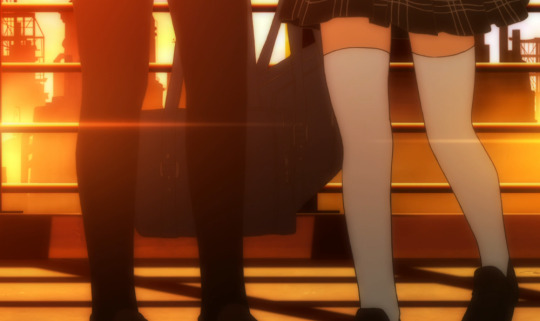


Homura won’t allow herself to be happy, won’t think she deserves to be until Madoka is safe, but that goalpost gets farther and farther away ‘cause Madoka only gathers more and more karmic potential - so all that does is make sure she never gets to be happy, because her fight will never really be over.
And I might just be reaching here, but that kind of emotional repression, coupled with the feeling of never doing enough to deserve happiness, because no matter how hard you work or how much you sacrifice, you’re still just a flawed human standing against a system that’s designed to crush you - that just screams Catholic guilt to me. And while we don’t know if Homura is or ever was Catholic herself, we know she did go to Catholic school, which clearly still colors a lot of her language and worldview.

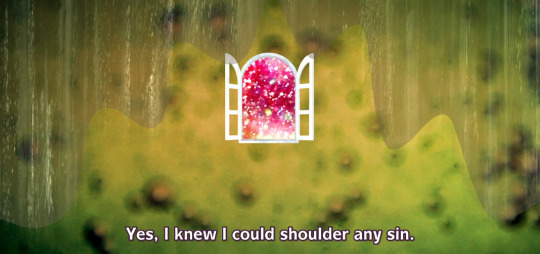
It’s not uncommon for Catholics to “accept” LGBT+ people, but only so long as they’re aware it’s a sin and seek penance for it and keep it to themselves - so plenty of LGBT people who grow up Catholic can acknowledge their feelings and even entertain them to a certain extent, but still struggle to outright act on them. And Homura’s feelings have the added burden of being astronomically strong (I’ll get back to that) which would put off anyone who didn’t know any better - so as they grow over time, she can show less and less of them, but having to repress them also gets harder.


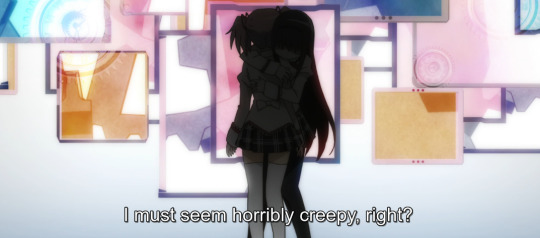
Her literally and figuratively making Madoka her god is an extension of all of that. It’s just much, much easier to justify your feelings for someone if you convince yourself that they are perfect, unreachable and untouchable, because a) They stop being human. They’re a god, and you’re supposed to worship gods, right? b) You can’t do anything to a god. You can’t hurt them or ruin them or make them uncomfortable no matter how much you love them c) A god can’t love you back, so there’s no risk of your feelings being encouraged.
Which brings me to the scene with Madoka’s statue. This scene happens when Homura’s trying to figure out who could’ve trapped all of them in a labyrinth, therefore disrespecting Madoka’s last wish and sacrifice. She makes a big show of caring about Madoka first, about Madoka only - she can’t even spare one second to feel glad that she got to see Madoka again before jumping to Whoever did this is wrong and evil and must be stopped because this is what Madoka gave her life for.

And while all of this is going on, her familiars are mocking her because they know damn well the person who did this is Homura herself, which is proof that as much as she claims to worship Madoka, to only want what she wants, to be serious about respecting Madoka’s wishes, there is also a part of her that wants her there, that lured her into her labyrinth because she missed her.

We flash back to this scene again when Homura realizes she is the witch, except now Homura sees herself touching Madoka’s statue and staining it. That’s usually the scene people point to when talking about Homura having internalized homophobia, because it can be read as Homura feeling like wanting to be with Madoka again (and inadvertently acting on that desire as a witch) is tainting Madoka’s sacrifice, or as Homura feeling like her love is tainting Madoka herself.
And I think those interpretations are inextricably linked, because the queer coding in Homura’s whole arc is very much intentional. Even when it’s not outwardly about her being a lesbian, everything she goes through resonates so much with every part of the queer experience that it still winds back around to her being a lesbian. Homura has tried so hard to repress the part of herself that doesn’t just want Madoka, but wants her with her; she’s tried to put Madoka’s wishes before her own, and convinced herself that she’s fine with it - but well, witches don’t have that kind of restraints. So Homura is forced to recognize that she’s not happy just standing at the feet of Madoka’s statue and worshipping stone, and that makes the illusion shatter.
And once she stops being able to ignore that she doesn’t see Madoka as a god, not really; and that Madoka maybe didn’t want to be a god in the first place; that’s when she decides to take matters into her own hands.
Remember what I said about Homura’s feelings for Madoka being astronomically strong? What I mean is that they literally aren’t bound to the laws of the universe, because they exist outside of the cycle of hope and despair. Rebellion and Wraith Arc especially imply that her magic is self-sustaining because her magic and her love for Madoka are the same thing - meaning that as long as Homura keeps loving her, there is nothing she can’t do (they actually explain the mechanics of it in Wraith Arc, but it would make this meta even longer and more convoluted than it already is). She is an anomaly, on par with Madoka (maybe even because of Madoka, in much the same way Madoka only became as powerful as she is because of Homura) - so when she says that no one could possibly understand her, that this feeling is hers and hers alone, I believe her! But that’s also just the queer experience again - thinking you’re the only one who’s ever felt like this, that no one could possibly understand you, that somehow what you feel is different and more powerful and potentially more dangerous than all other kinds of love.
But it’s also the only thing that can save Madoka, and we know Homura would damn herself for her. She was willing to die in her labyrinth, away from the Law of Cycles, in despair for all of eternity, to keep Kyubey from getting to Madoka - why not take it one step further to give Madoka a chance at being truly happy? Her love made Madoka a god in the first place, so it stands to reason that if Homura puts her mind to it, it can tear her down and make her human again.
So Homura finally sets that love free. She reaches out and takes Madoka’s hands and declares her love for her to everyone who’s listening. She takes the disruptive potential her love has and takes advantage of it, because Madoka used her infinite power to make the magical girl system a little bit kinder to everyone but Homura looks at the system that's causing the girl she loves so much pain and says the system is wrong - and then demonizes herself for it. But she sets it free nonetheless.
It’s not too different from magical girls releasing their despair and turning into witches, although Homura is obviously affecting the world on a much larger scale. I’m saying this not to claim that Homura had no control over her actions and therefore did nothing wrong, but to point out that magical girls needing to make peace with the uglier parts of themselves is an important part of the show. That’s why Sayaka being able to summon her own witch at will was so powerful - because we’ve seen her struggle through the series and fall into despair, and we see her now having full control over her emotions and using the darkness she knows is inside her to her advantage, to be stronger, instead of suppressing it. And I definitely think Homura needed to release those feelings too instead of keeping them locked up and beating herself up over them, because there’s so much power in them - as much potential for good and positive change as they’ve got for destruction - and releasing them is the first step towards embracing them.
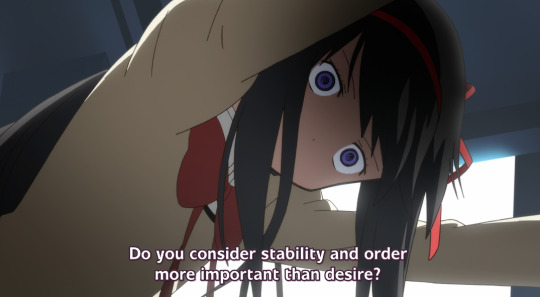
Obviously everyone will have different interpretations of this scene, but to me, this is the closest Homura has ever come to asking Madoka if she reciprocates her feelings. Or at the very least, if she can accept them. And Madoka (who has no context for this whatsoever) says No.
But for Homura to be able to ask Madoka if she’s allowed to be selfish, if she’s allowed to act on her desires at all, even if the only reason she’s asking is that at this point she’s got nothing left to lose - well, it’s huge.
I’m not going to say the way Homura went about things was right or even good for her, considering she is very clearly riddled with guilt and Rebellion is overflowing with suicidal imagery - but also there’s something to be said about how sometimes, accepting you’re the devil and going to hell anyway can give you the freedom to explore and potentially embrace parts of yourself you’ve always been too afraid to act on. So, mixed bag?
#madohomu#homura akemi#madoka magica#god i hope this makes sense. this is actually just four different metas in a trenchcoat#mothicalspoken
184 notes
·
View notes